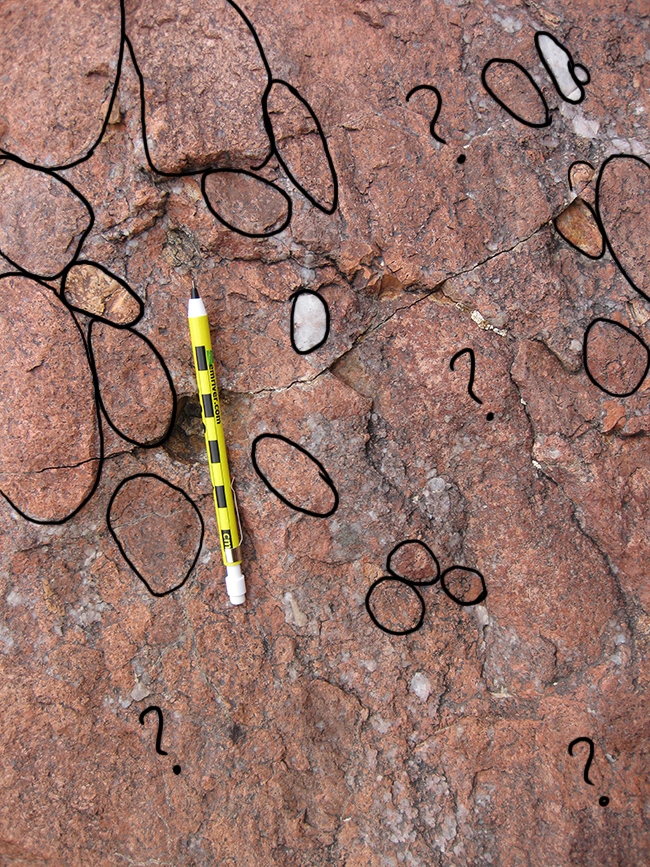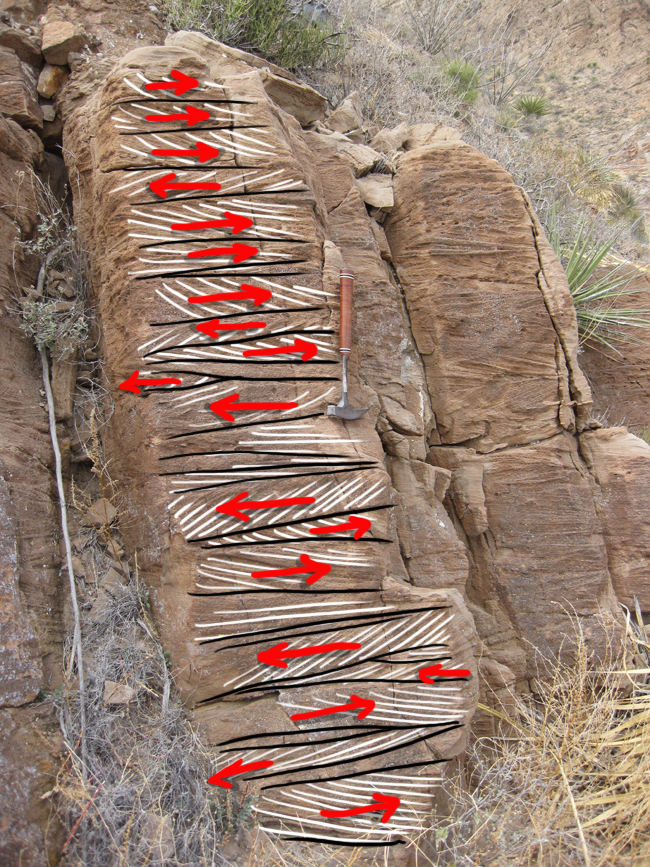Good morning! Let’s take a walk up the east side of the Franklin Mountains, north of El Paso, Texas, to walk across the Great Unconformity.
The basement rock exposed here is the Red Bluff Granite, a 1.1 Ga felsic magma that intruded the columnar basalts of the Mundy “Breccia” and the Castner Marble. (It is unknown what substrate the Castner Marble was deposited upon.) This is what the Red Bluff looks like from the parking lot of the Wyler Aerial Tramway, which we rode to the crest of the Franklins on a very cold and windy morning.

Typical high-potassium granite. Now let’s climb up the trail…
It’s hard to spot where you leave the Red Bluff and enter the overlying conglomerate, which is made of Red Bluff cobbles and pebbles. It’s called the Coronado Hills Formation, and this is what it looks like:

This isn’t a granite. It’s a conglomerate. Yes, I know: the cobbles are really hard to spot. Let me outline a few that I spotted, and then you can go back to the unannotated original photo and see if you can spot any others.

Atop this is the Bliss Formation, a Cambrian quartz arenite (quartz sandstone). It has Skolithos trace fossils in it, just like Virginia’s Antietam Formation (which is of the same age):

Though these aren’t the most impressive Skolithos I’ve ever seen, they are at least diagnostic of vascularized body plans, and therefore of the Cambrian period of geologic time.
Better yet, or at least more impressively expressed, are the cross-beds:

Notice how in one bed, the cross beds tilt to the left, and in the next, they tilt to the right. This is indicative of currents that shift direction. Sometimes, it’s dubbed “herringbone” cross-stratification.
Here’s another lovely exposure showing these primary sedimentary structures:

Beds highlighted in black, cross-bedding in white, and the interpreted current flow direction shown with red arrows:

A great little hike – gaining 500 million years in far less than 500 vertical feet.

Awesome crossbedding! Coupla questions:
1) You don’t mention how old the conglomerate is, so I’m wondering exactly where the “Great Unconformity” lies: between the granite and the conglomerate, or between the conglomerate and the quartzarenite? I’m guessing the former, but there would also seem to be a pretty radical shift in provenance (and flow regime!) at the very least between the conglomerate and the sandstone: straight from K-spar to quartzarenite with no arkose(!)
2) Is the contact between the conglomerate and the sandstone exposed at this location?
No actual exposed contact – or you know I would have photographed it.
Unconformity above the granite, below the conglomerate, for a nonconformity, sensu stricto. There may be an additional disconformity between the conglomerate and the sandstone, with additional time missing there, but if so, I don’t know about it. There were intervening glauconitic sands (also Bliss) that my camera would not cooperate in photographing.
Joshua Villalobos, who led the hike, knows much more than I do. Perhaps he’ll chime in with a response.
Howard,
1) The conglomerate is part of just one of the formations that is part of what is collectively called the Thunderbird Group.This conglomerate layer is part of the Coronado Hills Fm. which also contains arkosic sandstones further up in the section. This unit also sits above the Red Bluff Granite (radiometrically dated to ~980 m.y.o +- 20 m.y.) and is the oldest of the Thunderbird Group. The upper most (youngest) formations within the Thunderbird Group are volcaniclastic (trachytes, ignimbrites, and rhyolites) and have dates ranging around ~950 m.y.o. +- 10 m.y. inferring a relationship between the Red Bluff being the source of the Thunderbird’s volcaniclastics.
2) In this section, the contact between the Precambrian Red Bluff Granite/Thunderbird Group and the Bliss Sandstone (~500 m.y.o. based on fossil evidence) is not very distinct. The classic Great Nonconformity that we show in El Paso is in Mckelligon Canyon where the Red Bluff Granite lies directly below the Bliss Sandstone, to the point where you can place your hand on both units (http://www.geo.utep.edu/pub/aapg/pictures/oct04/oct23.JPG)!
Hope this answers your questions!
It does, indeed–thank you!